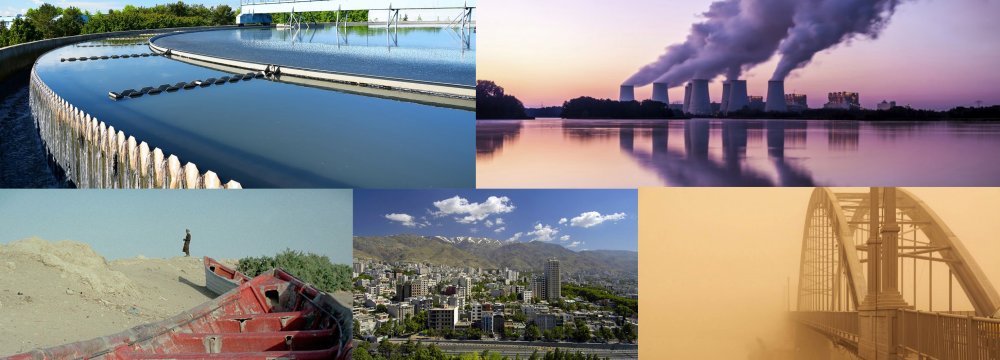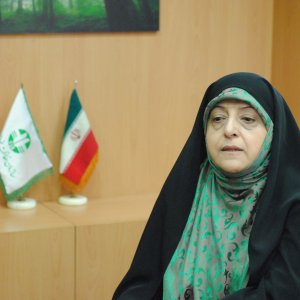
Iran 2016 Environment Review

Iran’s environmental scene has witnessed both good and bad developments in 2016.
Wildfires raging through forests in summer, the persistent air pollution choking metropolises and dust storms hitting southeastern parts of Iran have been the most challenging events of the year.
Nevertheless, officials have taken promising measures, raising hopes that the country’s environment would turn the right corner.
Financial Tribune reviews what the Iranian environment went through this year:
January: The year started with the 10th Green Management Awards (Energy Globe World Awards 2016) honoring Tehran Oil Refining Company with the green management certificate in Tehran.
The Department of Environment endorsed the “Car-Free Tuesday” campaign launched by environmentalists in Arak, one of Iran’s eight polluted metropolises. The campaign is aimed at helping raise awareness about the role of public in reducing air pollution.
Fifty hybrid taxis were added to Tehran’s public transportation fleet and officials announced plans to replace 15,000 decrepit cabs by the end of April.
The 5th Regional Conference on Climate Change focusing on global warming, drought and dust storms and their impact on the Middle East opened in Tehran with foreign experts on meteorology and environment in attendance.
Iran fell 22 spots in the latest Environmental Performance Index ranking, which was released on in late January at the World Economic Forum in Davos, Switzerland.
February: A yearlong research to study Hamoun Wetlands in southeastern Iran was completed. The first of its kind, the study helped researchers gain a better understanding of the wetlands’ topography, allowing them to pinpoint the areas where restoration efforts should begin.
DOE issued its long-awaited plan to protect the rare Persian leopard. Touted as the first-ever document of its kind in Iran, the comprehensive plan included short- and long-term goals and outlined measures to monitor the animal’s population, raise awareness and encourage public participation in conservation schemes.
Iran and Germany signed a memorandum of understanding to cooperate in constructing environment-friendly housing in Hashtgerd, Alborz Province, as well as in Isfahan.
Public offices and schools in Khuzestan Province were closed 22 Feb. due to the dangerously high concentration of PM10 (particulate matter with a diameter of 10 micrometers or less) in the air.
March: The 15th International Environment Exhibition, the first major environmental event to take place after lifting of western economic sanctions inJanuary, was held in early March.
About 100 NGOs from 31 provinces participated, a testament to DOE’s stated goal of empowering community-based groups to raise environmental awareness.
The crucial Environmental Assessment Bill failed to secure the necessary votes in the parliament. The DOE-sponsored bill aimed to control construction projects by making environmental impact assessment and its enforcement mandatory, which would compel developers to comply with environmental regulations.
April: The Japanese government donated $1 million to help efforts aimed at restoring Lake Urmia in northwestern Iran.
Rural residents and shepherds across Iran were insured against loss inflicted by the Persian leopard, after a memorandum of understanding signed between DOE and Ma Insurance Company.
President Hassan Rouhani instructed the Agriculture Ministry late April to enforce measures outlined in an international agreement for promoting the sustainable use of Caspian Sea and protecting its marine life.
May: Scientists at Iran’s Meteorological Research Center devised a model to predict the concentration of particulate matter in the air on an hourly basis for up to 72 hours in Iran and the Middle East.
In mid-May, the 73 artifacts returned to Tehran by the Unites States were displayed at the National Museum in Tehran.
A resolution proposed by Iran and backed by Pakistan and Iraq, which aims to enlist the aid of Middle East countries to tackle dust storms in the region, was approved at the Second UN Environment Assembly held in late May.
June: In early June, around 3,000 hectares of Fars Province’s forests in the vicinity of Pasargadae, the tomb of Cyrus the Great, burned to the ground in what is the worst case of wildfire in the current Iranian year (started March 20).
The Council of Ministers approved a roadmap containing a set of guidelines aimed at reducing air pollution in Iran’s eight metropolises and notified relevant bodies about their duties.
Three park rangers were killed on duty in the span of two days in Geno Biosphere Reserve in Hormozgan Province and Bamou National Park in Fars Province. The deaths compelled both environmental officials and activists to demand better legal protection for these dedicated park wardens.

July: DOE prepared a bill to enhance the rights of park rangers and presented it to First Vice President Es’haq Jahangiri.
It was also in this month that DOE ordered the release of 20 million cubic meters of water to the imperiled Hamoun Wetlands to reduce the intensity of dust and sandstorms in Sistan-Baluchestan Province, especially the city of Zabol that had earlier been ranked by the World Health Organization as the most polluted city in the world (based on PM2.5 concentration).
Residents of Khuzestan Province, especially in its central city Ahvaz, were forced to remain indoors for several days, as the mercury sizzled its way to 60 degrees Celsius.
About 30 hectares of forests and pastures in Kohgilouyeh-Boyerahmad Province caught fire three times in early July. Fires were thought to have been started by campers.
August: French Ecology, Sustainable Development and Energy Minister Segolene Royal, who is also the president of COP21 (the Paris Climate Conference), travelled to Tehran on a three-day visit to discuss environmental issues with top Iranian officials.
The Paris Agreement Bill, which outlines the government’s measures to reduce greenhouse gas emissions by at least 4%, was also submitted to the Majlis by the government for ratification.
Following a directive issued by the High Council for Environment in official Persian newspapers on August 8, Abr Forest in Shahroud, Semnan Province, was legally designated as a protected area, giving DOE the mandate to enforce conservation measures there.
The Council of Ministers, led by Jahangiri, approved the allocation of $500 million from the National Development Fund of Iran to upgrade agricultural irrigation systems across the country.
The return of whiteflies caused a nuisance in the capital once again and persisted for days in spite of Tehran Municipality’s intensified measures.
September: The 35-article Clean Air Bill, which imposes hefty fines on all sources of air pollution that exceed emission limits among other things, was passed by Majlis Agriculture, Water and Natural Resources Commission, paving the way for its passage in the parliament before being signed into law by President Hassan Rouhani.
Iran’s Sharif University and the University of Melbourne in Australia agreed to set up a center on water research to use Australia’s expertise in battling the water crisis facing Urmia Lake in northwestern Iran.
Iran and Austria signed a memorandum of understanding in Vienna covering a wide array of topics from the exchange of knowhow to cooperation on environmental and marine research, and implementation of the Paris Agreement.
Exclusive Interview: Gov't Picking Up the Slack

DOE chief, Massoumeh Ebtekar, in a wide-ranging interview with Financial Tribune in which she criticized past governments for not giving the environment the attention it needed, leaving the current administration to pick up the slack.
Read the article on financialtribune.com >
October: This month bore good news for the water management sector. The Drought and Environment Headquarters at Iran’s Vice Presidency for Science and Technology signed a memorandum of understanding with the French firm Suez Company to benefit from the latest technological advancements in water management and receive assistance with research projects.
The topic of elevating DOE to a ministry was raised in October and a number of lawmakers, including Ali Mohammad Shaeri and Abdolkarim Hosseinzadeh, supported the move.
The results of an animal census carried out in the last Iranian year (ended March 19, 2016) were also publicized, showing an increase in the populations of deer and ovis but a decline in the number of wild goats.
November: This was when the Paris Agreement, which had gone into force worldwide on November 4, was finally ratified by the Majlis, making Iran 106th to approve the plan.
The all-too familiar smog, which normally descended in late December or early January, shrouded the Iranian capital, as well as Arak, Isfahan, Karaj and Qazvin, earlier this year in November, much to the surprise of meteorological authorities.
A bill to prevent animal abuse was prepared by DOE, approved by the government and submitted to the parliament.
December: Provincial offices of DOE stopped issuing bird hunting licenses to prevent a potential outbreak of avian influenza (or bird flu) among migratory birds flying from Russia and India, which are usually hunted for their meat.
Tehran experienced consecutive days of dangerously high pollutant levels in late December, which led to the shutdown of preschools and primary schools. Air quality improved only slightly and remained unhealthy for sensitive groups, despite windy conditions that were expected to scatter the pollutants.
The publication of a comprehensive guide detailing key information on 10 living and extinct cat species in Iran, following a joint project between Iranian and international experts, enriched Iran’s biodiversity database.


Trump weighs using $2 billion in CHIPS Act funding for critical minerals

Codelco cuts 2025 copper forecast after El Teniente mine collapse

Electra converts debt, launches $30M raise to jumpstart stalled cobalt refinery

Barrick’s Reko Diq in line for $410M ADB backing

Abcourt readies Sleeping Giant mill to pour first gold since 2014

Nevada army depot to serve as base for first US strategic minerals stockpile

SQM boosts lithium supply plans as prices flick higher

Viridis unveils 200Mt initial reserve for Brazil rare earth project

Tailings could meet much of US critical mineral demand – study

Kyrgyzstan kicks off underground gold mining at Kumtor

Kyrgyzstan kicks off underground gold mining at Kumtor

KoBold Metals granted lithium exploration rights in Congo

Freeport Indonesia to wrap up Gresik plant repairs by early September

Energy Fuels soars on Vulcan Elements partnership

Northern Dynasty sticks to proposal in battle to lift Pebble mine veto

Giustra-backed mining firm teams up with informal miners in Colombia

Critical Metals signs agreement to supply rare earth to US government-funded facility

China extends rare earth controls to imported material

Galan Lithium proceeds with $13M financing for Argentina project

Kyrgyzstan kicks off underground gold mining at Kumtor

Freeport Indonesia to wrap up Gresik plant repairs by early September

Energy Fuels soars on Vulcan Elements partnership

Northern Dynasty sticks to proposal in battle to lift Pebble mine veto

Giustra-backed mining firm teams up with informal miners in Colombia

Critical Metals signs agreement to supply rare earth to US government-funded facility

China extends rare earth controls to imported material

Galan Lithium proceeds with $13M financing for Argentina project

Silver price touches $39 as market weighs rate cut outlook

















